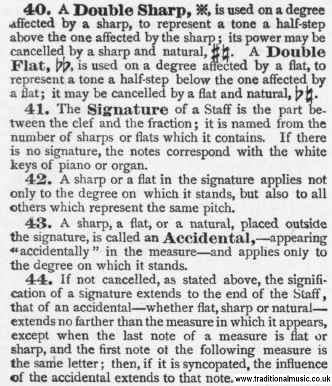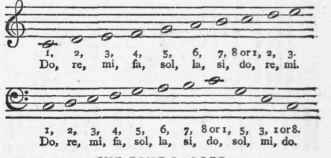Favorite Songs and Hymns For School and Home, page: 0375
450 Of The World's Best Songs And Hymns, With Lyrics & Sheet music for voice & piano.
| Share page | Visit Us On FB |
|
FAVORITE SONGS FOR SCHOOL AND HOME. |
375 |
|||
 |
The names of the notes, Do, Re, Mi, etc., vibrate throughout the scale, their places depending wholly upon the location of the Key-note, which is always called Do, and numbered one.
48. Therp are, as has already been said, two kinds of intervals in the Diatonic scale: Step* and half-steps, the intervals between 3 and 4, and 7 and 8, being half-steps, while all the others are steps. The half-steps, or semi-tones, should always be sung " sharp," the voice being slightly pressed or drivei above, rather than permitted to fall below the torn indicated by the note upon the staff.
44). In writing the Scale, any tone may be take as one, or Do; when this is determined, the other must follow in regular order In the examples below, one or Do is placed on C, as the intervals of the staff beginning with C, correspond with those of the scale All the steps in the key of C are therefore natural steps. As shown in the following examples, the seal is extended upwards, by regarding eight, or the octavt above one, as one of an upper scale, and downwards by regarding one as eight of a lower scale.
5O. The Scale, as written upon the staff, in the key of C, in both clefs, is as follows:� |
|||
 |
||||
|
THE DIATONIC SCALE. |
||||
|
45. The Relative Pitch of tones is indicated by a Scale, or Tone Ladder.
46. The Diatonic Scale, generally called the Scale, consists of a regular succession of intervals from the key-note to the octave, 1st, 2d, 3d, 4th, 5th, 6th, 7th, 8th, or octave, it having been found most agreeable to join to the seven sounds of one group the first of the next higher, making eight in all. The key-note is the first note in the Scale. This Scale is also called the Major Scale, to distinguish it from another scale, having its semitones in different order, and called the Minor Scale. In the compass of the scale there are five whole tones or degrees and two semi-tones or half-degrees. Commencing on C, that is making C one of the scale, these semi-tones are found between the 3d and 4th and 7th and 8th degrees. Here we find between the 1st and 3d degrees two whole tones, making a "major" or greater third. All music written on the scale when so constructed is said to be in the major keys; and this scale can only be formed from the notes in their natural order by commencing on C. There is, however, another series of notes, equally well-fitted for expressing musical ideas, which is formed by commencing on A instead of C, and which, in the natural order of tones, can begin only on A In this scale the semi-tones always fall between 2 and 3 and 5 and 6. Here between the 1 st and 3d degrees there are not two whole tones, but only a tone and a half, making the " minor " or lower third. All music written on the scale when so constructed is said to be in the minor keys, which are often most expressive.
47. The tones are named by Numbers and also by Syllables, the latter to afford greater variety of vowel sounds for practice, as well as to form an easy associa�tion of degree name and relative pitch of tone�the same syllable being always used in singing the same tone. Do is always one, Re always two, and so on. The numbers and syllables are as follows:
By numbers: 1, 2, 3, 4, 5, 6, 7, & By syllables: Do, Re, Mi, Fa, Sol, La, Si, Do. (Pronounced Doe, Ray, Mee, Fan, Sole, Lah, See, Doe.) |
||||
|
THE TONE LADDER.
51 The fact that these Eight Degrees include every possible distance except the none and deceme (ninth and tenth), at which musical tones can be placed from each other, was discovered some centuries ago in Italy. When sung consecutively the thought of ascending or descending a ladder was naturally suggested,and the term "Scale" (Italian word Scala, meaning "ladder") was adopted. The propriety of the name has caused it to be retained by musicians. The order of tones being a " ladder," the distances between them are naturally called steps. The tones of the Scale can only be learned by imitation.
The Scale or Tone Ladder may be drawn or neatly painted on the blackboard for permanent use in the form here shown, six or eight inches wide and eigh�teen high, which will afford spaces three inches in height to represent tone intervals, and one and a-half inch spaces for the semi-tones. Let the scale names and numbers be given as here. The exercises should be written by the side of the scale in hold fig�ures. Commas may be used after the figures to in�dicate short notes, and the dash for notes prolonged. With the pointer, the teacher can direct the work of the class more readily, singing the exercises back�wards as well as forwards, by numbers, by syllables, by letters, and by simple vowel sounds.
The following exercises which may be placed upon the board, as well as sung from the page, will afford much variety of useful practice. They may be greatly varied, and supplemented by others to almost any ex tent But it is advised that, at first, they be taken ha the order here presented, in short lessons, so that noth�ing is passed that is not well learned. Let this drill exercise be pleasantly varied by rote singing�at�tractive songs and familiar hymns being preferred� |
||||
 |
||||